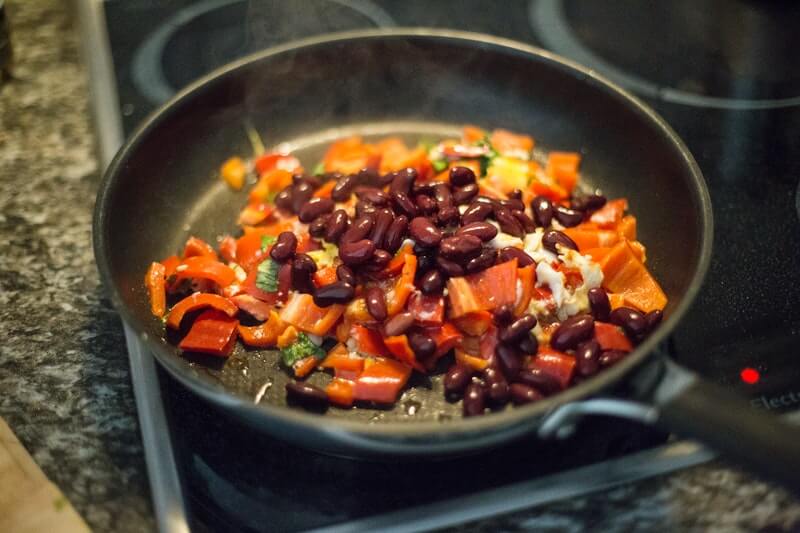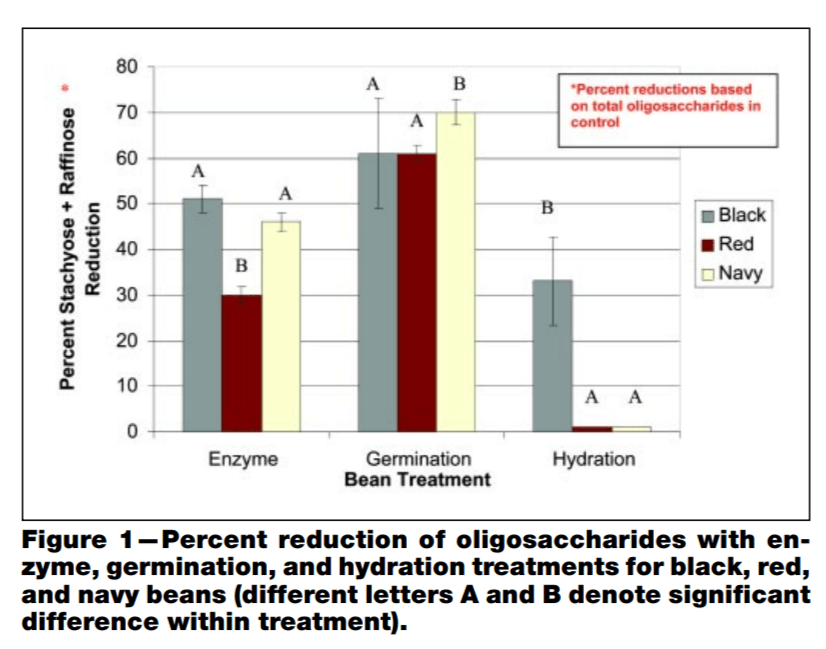Black beans and kidney beans (the most popular red bean) are two of the most popular and easiest types of beans.
If you’re curious which is healthier, or which has the better macro profile, you’ll find the answer here.
I’ve done a brief comparison of the 2 types of beans, divided into 3 sections.
Table of Contents
Taste of Black Beans vs Kidney Beans
These 2 types of beans taste quite different:
- Black beans – Fairly hard, with an earthy texture. They go well in South and Central American recipes.
- Kidney beans – A red bean that’s a bit softer than black beans, and not too strong of a flavor. I think I’d say they’re “hearty” beans, which is why they go so well in meals like chili.
If you’re eating them without much seasoning, kidney beans will likely seem a bit too plain, but they soak up flavors easily, which is why they’re so versatile.
One last difference to mention here is that black beans are smaller than kidney beans.
Can I Use Black Beans Instead of Kidney Beans?

All beans are interchangeable to some degree, and in most cases you can swap kidney beans for black beans (or the other way around).
Let’s look at a common case where beans are important – chili.
Most chili recipes take one of two approaches:
- Only have kidney beans (more traditional)
- Have both kidney and black beans (usually in a 1:1 ratio) – like our high protein vegan chili recipe.
The fact that many recipes already swap in some black beans for kidney beans pretty much tells you that you can substitute black beans for kidney beans in chili if needed.
Nutritional Value Comparison
Beans have a few vitamins, but are mostly known for the minerals that they contain.
Here’s a quick comparison table of the nutrients in both beans, note that other red beans have a very similar profile as kidney beans:
| Black Beans (%DV) | Kidney Beans (%DV) | |
|---|---|---|
| Serving size | 1 cup | 1 cup |
| Vitamin K | 0% | 19% |
| Thiamin | 28% | 19% |
| Vitamin B6 | 6% | 11% |
| Folate | 64% | 58% |
| Calcium | 5% | 6% |
| Iron | 20% | 22% |
| Magnesium | 30% | 19% |
| Phosphorus | 24% | 24% |
| Potassium | 17% | 20% |
| Zinc | 13% | 12% |
| Copper | 18% | 19% |
| Manganese | 38% | 38% |
Almost all of them are exactly the same. The only significant difference is that kidney beans have way more vitamin K, but vitamin K is easy to find in other foods.
Note that either way, both deliver a ton of overall nutrition. You’ll find many beans on the list of top vegan sources of vitamins like folate.
Iron is one of the more important minerals that a lot of people are lacking, and kidney beans do have a bit more, but it’s not a big difference.
Neither Black beans or kidney beans are significantly more nutritious than the other in terms of vitamins and minerals.
Protein and Macros of Black and Kidney Beans
Looking to build muscle?
Let’s take a look at the main macros for black and kidney beans.
| Black Beans | Kidney Beans | |
|---|---|---|
| Serving size | 1 cup | 1 cup |
| Calories | 227 | 225 |
| Fat | 0.9 g | 0.9 g |
| Carbohydrates | 40.8 g | 40.4 g |
| Fiber | 15 g | 11.3 g |
| Protein | 15.2 g | 15.3 g |
Unlike some beans like soybeans, when it comes to black beans and kidney beans, everything from calories to protein is virtually the same.
Black beans have more fiber if that’s important to you, but it’s probably not an issue if you’re eating beans in the first place.
Which is Better For Gas?
Beans and flatulence is an infamous combination.
We’ll look at 2 main causes of this, and what you can do to reduce stomach problems.
Reason #1 – High Fiber Content
As we saw before, one cup of cooked beans for these 2 types have:
- Black beans – 15 grams of fiber
- Kidney beans – 11.3 grams of fiber
Based on fiber, black beans are more likely to cause gas.
Reason #2 – High Oligosaccharide Content
Oligosaccharides are one type of sugar that’s particularly hard for people to digest.
They don’t absorb well in the stomach or small intestine, and then go on to ferment in the large intestine (which produces gas as a byproduct). It’s really not too different from fiber.
It’s tough to find data on this, since it’s not on any nutrition label, but one study did find that black and kidney beans have roughly the same amount of oligosaccharides (source):
Throughout these experiments, all 3 bean classes showed similar initial raffinose and stachyose levels: 0.5% to 0.7% dry basis for raffinose and 3% to 4% dry basis for stachyose.
Note that raffinose and stachyose are the 2 most common types of oligosaccharides you’ll find in legumes.
Reducing Gas From Beans
That same study looked at 3 approaches for reducing oligosaccharide content in black, red, and navy beans:
- Enzyme treatment – You might have seen bean enzyme products like Bean-o that promise to reduce flatulence. They break down these stubborn starches to aid digestion.
- Hydration – Simply soaking dry beans in water for an extended period
- Germination – Involves soaking as a first step, and continuing to water until they sprout (longest, but most effective option).
It turns out that black beans respond better to these methods than red (kidney) beans, especially hydration.
That makes it tricky to say which bean will produce less gas for most people.
On one hand, black beans have more fiber than kidney beans. However, black beans will have a lower oligosaccharide content if you soak or sprout them. Overall, it depends on individual factors since some people will react more to one of these issues more than others.
What’s the Difference Between Black Beans and Kidney Beans
Nutritionally speaking, both black beans and kidney beans are virtually identical. They have almost the same calories, fiber, and vitamin content.
The only real difference is the taste.
The same thing goes for black beans vs pinto beans or kidney beans vs pinto beans.
Since there’s no “best” one, just eat the one you like the taste of the most.
Or better yet, eat both!

